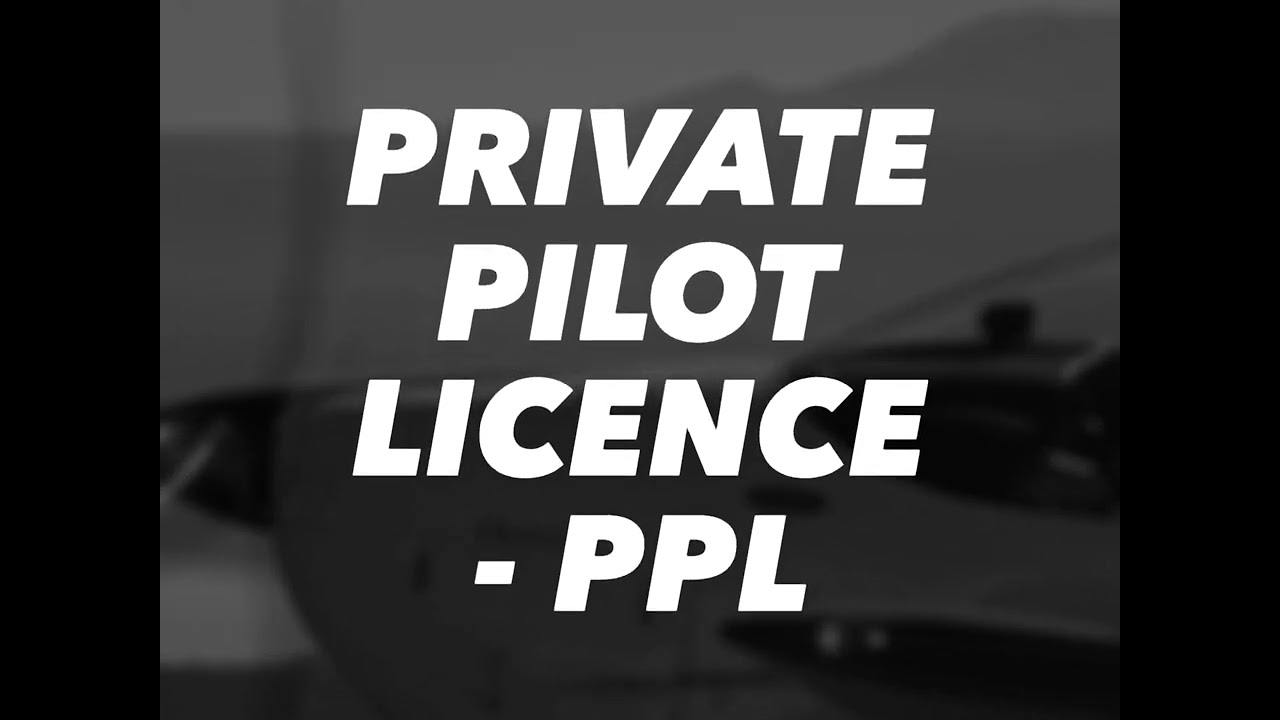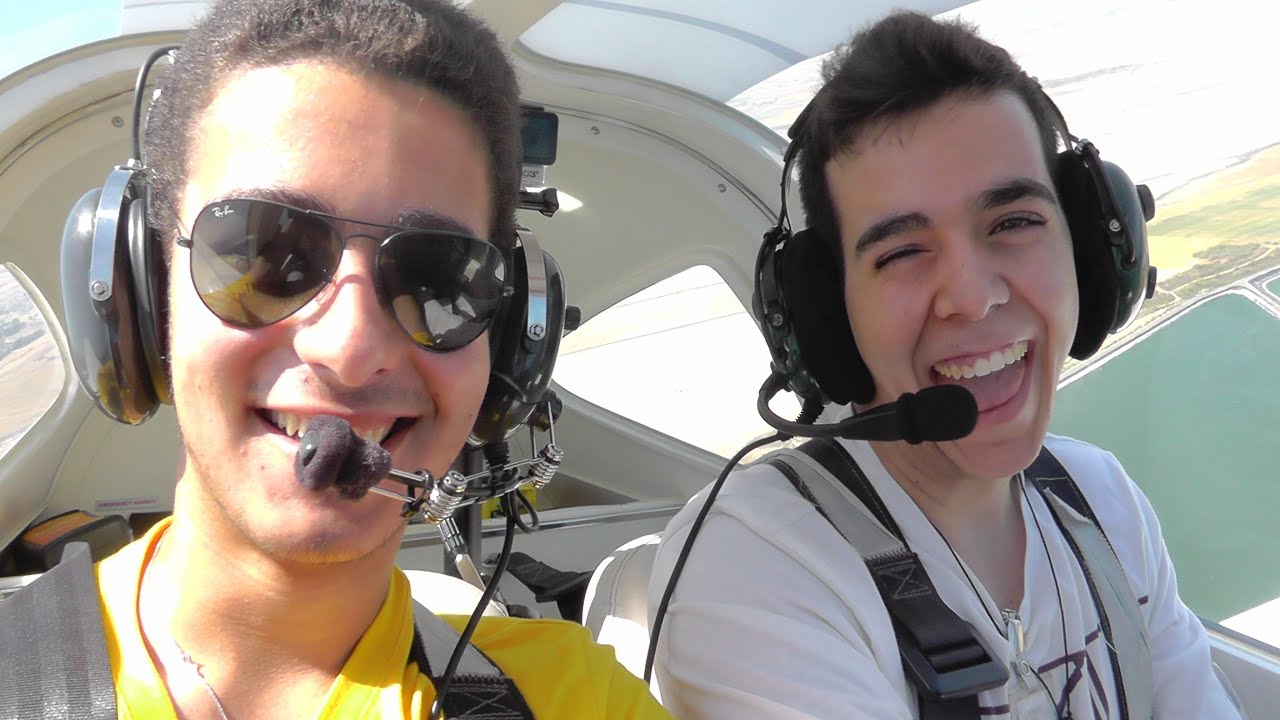Tecnam P2002 JF
Tecnam P2002-JF
Our primary training aircraft is the TECNAM P2002-JF model which are EASA certified under CS-VLA rules and are therefore fully approved for practical flight training towards the Private Pilot Licence (PPL) in EASA Europe and the UK
Our TECNAM P2002-JF fleet continue to grow and currently include:
EC-NZS + PH-EPT + F-HFGX + PH-IGY + 2 more identical TECNAM's arriving in Dec 2025
Every aircraft has an Aircraft Maintenance Program (AMP) that has been developed in accordance with EASA Part-CAO - Continuing Airworthiness (Maintenance) Organisation - and are impeccably maintained by authorised EASA Part-66 (B3) Licenced Aircraft Maintenance Engineers (LAE) employed by TURMINA, our 'in-house' Part 145 General Aviation (GA) maintenance organisation located onsite at Son Bonet Airport (LESB). All EASA Airworthiness Directives (ADs) and TECNAM Service Bulletins (SBs) are complied with. Maintenance is never deferred. All aircraft are subject to regular 50-Hour maintenance checks, as well as, as required by law, the 100-Hour Inspection which covers a more detailed structural, engine and systems check. Additionally, Annual Inspections are performed by B3 LAE where the airframe is subject to disassembly and closer scrutiny. The ROTAX 912 ULS engines and Hoffmann propellers are replaced with brand new every 2,000 hours. Overall, the aircraft are in very good condition.

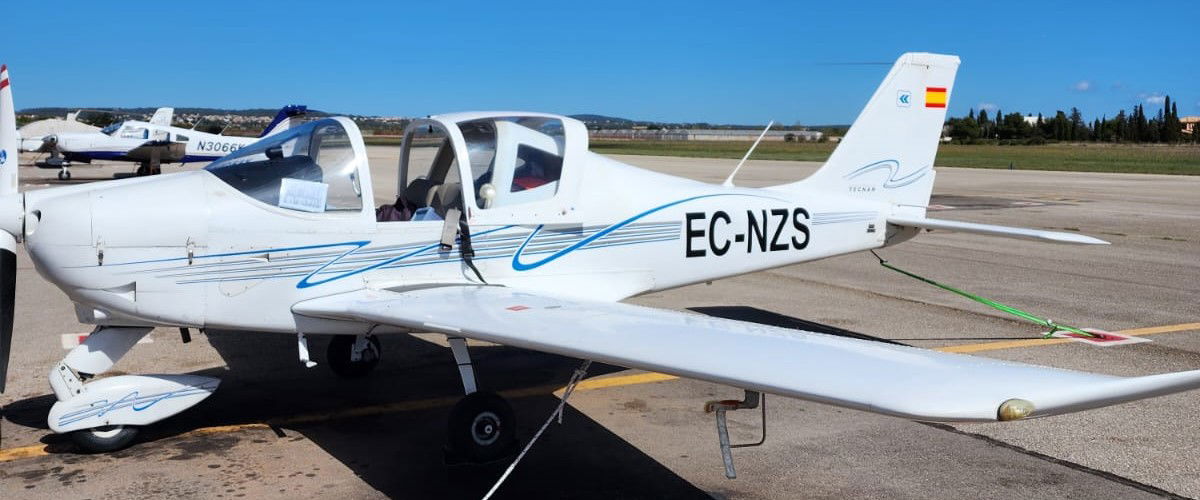
In 2016 the Argentine Air Force ordered the TECNAM P2002-JF as its primary trainer, as did the (Greek) Hellenic Air Force in 2018.
With a modern design and low operational costs, the TECNAM P2002-JF is Fly EPT Spain's training aircraft of choice. Easy to fly and maintain, the P2002-JF is an excellent aeroplane for the training of ab-initio student pilots.
TECNAM P2002-JF ✈︎ Aircraft Flight Manual (AFM)
The Aircraft Flight Manual (AFM), sometimes referred to as the Pilot Operating Handbook (POH), has been prepared to provide pilots and instructors with information for the safe and efficient operation of this very light aeroplane. Pilots should familiarize themselves with the AFM, Pilot Checklist, Radio Calls for Son Bonet Airport, as well as the Local Flight Rules around Mallorca.
TECNAM P2002 JF ✈︎︎ Pilot Checklist
Radio Calls for Pilots at Son Bonet Airport (LESB) + Mallorca
Local Flight Rules ✈︎ Mallorca & Son Bonet Airport (LESB)
Communications at Son Bonet Aerodrome Circuit ✈︎ AESA Safety Bulletin
Aircraft Documents Folder ✈︎ Checklist
Pilot Log (PLog) ✈︎ VFR Navigation Log (NavLog)
This is a free PLOG - Pilot Log - Used for VFR navigation planning, also called a NAVLOG. Download and customize, as you see fit
Type-Certificate Data Sheet
TECNAM P2002-JF Walkaround & Preflight Inspection
You can follow here Pilot Jonathon's inspiring journey from humble PPL beginnings flying the TECNAM P2002-JF all the way to flying Ryanair's Boeing B737
TECNAM P2002-JF Instrument Panel
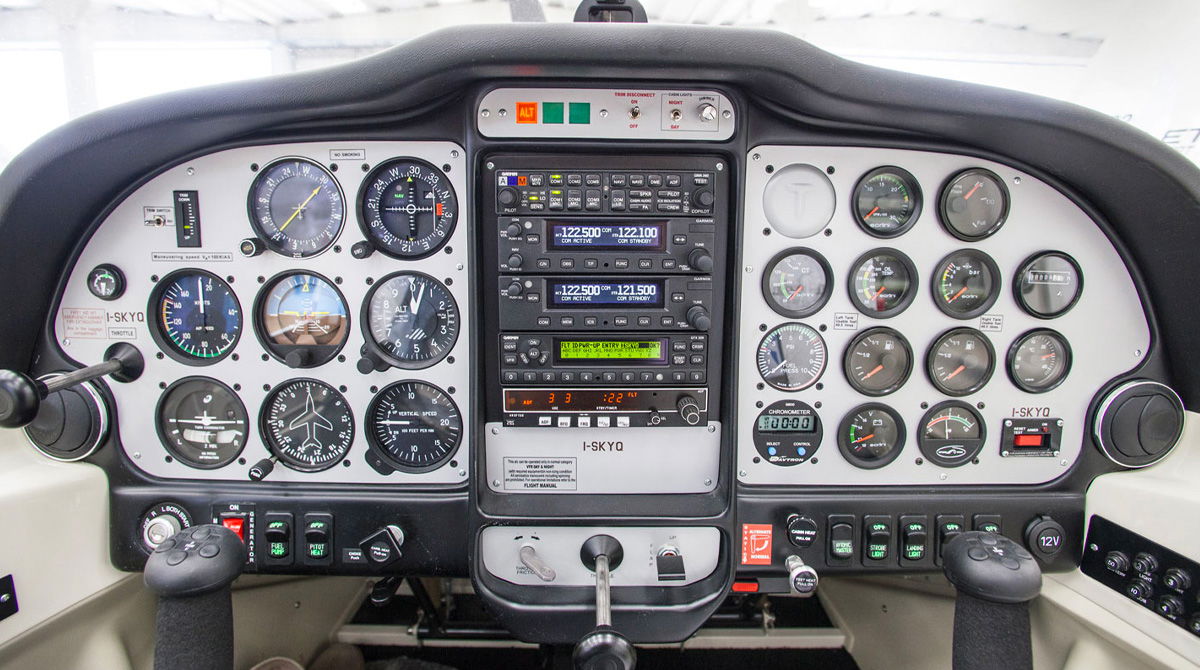
Garmin G5 Electronic Flight Instrument
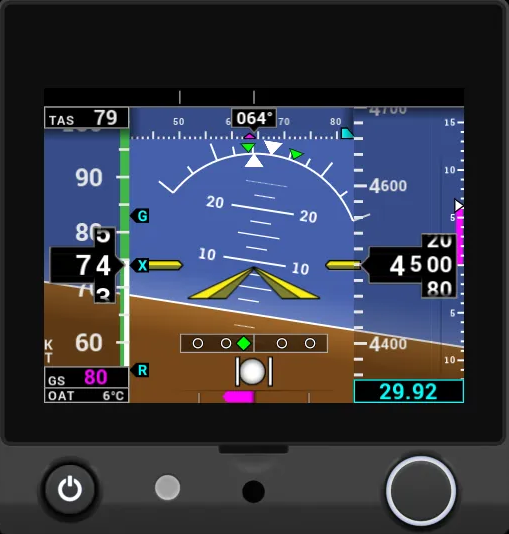
All TECNAM aircraft are being upgraded with G5 Garmin EFI
Tecnam P2002-JF
Features:
Low-wing, Single-engine aircraft. Fixed landing gear. Analogue instruments
Avionics
Our fleet of identical Tecnam P2002-JF aircraft have a Garmin 430 NAV/COM with a GMA 340 audio panel and a GTX-330 transponder Mode S which is an IFR-certified transponder with datalink capability, including local traffic updates. VFR button for quick-and-easy VFR squawking. Functions: flight time, count-up, count down timers, current pressure altitude. Remote ident and auto standby, altitude monitor with voice alerting. Level 2 Mode-S - satisfies upcoming European Mode-S mandate for Elementary Surveillance.

Garmin GMA 340 Intercom - Pilot's guide here - Watch the video how to use here and here
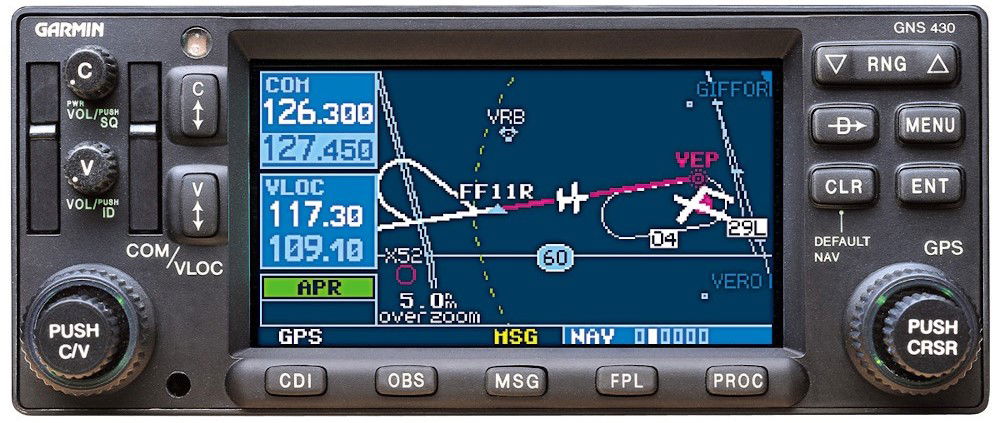
Garmin 430 - GPS/Nav/Comm - Watch video for instructions how to use here

GTX-330 Transponder - watch video how to use here
Technical Sheet
- Manufacturer: TECNAM (Italy)
- Max Seats: 2
Supplementary information
- Approved for Day & Night VFR flying
- Operations in non-icing conditions only
- All aerobatic maneuvers including spinning are prohibited
- Type certified by EASA in CS-VLA category (i.e. very light aircraft)
Performance - Fixed Pitch Propellor (Hoffman Fixed Pitch PN HO17GHM A 174 177 C)
- Max cruise speed: 122 KIAS (140 mph, 226 km/h)
- Stall speed (Flaps DOWN, power off): 41 kt. (76 km/h)
- Max Operating Altitude: 14,000 ft (Fly EPT Spain restriction: 10,000 ft AMSL due to )
- Range: 535 NM (991 km)
- Rate of Climb: 874 ft/min (4.4 m/sec)
- Take Off Run: 237 m (777 ft)
- Take Off Distance: 392 m (1292 ft)
- Landing Run: 164 m (538 ft)
- Landing Distance: 322 m (1056 ft)
Weight & Loading
- Baggage allowance: 20 kg
- Useful Load: 240 kg (i.e. passengers + cargo + fuel)
- Maximum Take Off Weight (MTOW): 620 kg
- Empty Weight, Standard: 380 kg
Note: To calculate weight of fuel / AVGAS / MOGAS ✈︎ 1 litre of AvGas / MoGas = 0.79 kg (density). Therefore, 100 litres (max fuel capacity) x 0.79 kg = 79 kgs
Powerplant
- Powerplant / Engine: Rotax 912 S2
- Engine Power: 100 HP
- Propellor: 2 Blade Fixed Pitch (Hoffman Fixed Pitch PN HO17GHM A 174 177 C)
Fuel
- Fuel tank capacity: 26 US Gal (100 liters)
- Two (2) wing fuel tanks: 13 US Gal (50 liters) each side
- Fuel Consumption: 4.5 USG/hr. (17 liters/hr.)
- Fuel type: MoGas and AvGas
Fuel indicator is calibrated as follows:
Indicator Fuel Quantity | Liters |
0 | 0.5 |
1/4 | 15 (+3 / -3) |
1/2 | 25 (+3 / -3) |
3/4 | 35 (+3 / -3) |
4/4 | 50 (+0 / -3) |
You must land at destination with NOT less than final reserve i.e. 45 minutes of fuel remaining i.e. a total of 13 liters (nearly 1/4 on the fuel indicator). If you know you will land at destination below the 45 mins final reserve limit, you shall declare:
'' MAY-DAY, MAY-DAY, MAY-DAY, FUEL '' over the radio to Air Traffic Control. This signals a full emergency when you anticipate landing with less than the legally required final reserve fuel, or 45 minutes. By declaring a Mayday fuel, ATC will provide immediate priority for landing and will take the necessary actions to ensure your aircraft lands safely.
Fuel endurance = 100 litres (total fuel) - 13 litres (final reserve) = 87 litres (useable fuel) / 17 litres/hour (fuel consumption) = 5:06 hours (approximate) maximum fuel endurance
To calculate the weight of AvGAS
The Specific Gravity (SG) of AvGAS (100LL) is a measure of it's density relative to water, and the approx. density of AvGAS ranges between 0.68 - 0.74, depending on the temperature. On a hot day, SG decreases, and vice versa.
Typical SG at 15 deg C, use SG value 0.72 Kg/L
On a hot summer day, use a slightly higher SG value of 0.74 Kg/L
On a cold winter day, use a slightly lower SG value of 0.70 Kg/L
For example, in flight planning, to calculate the weight of AvGAS fuel:
100 litres AvGAS x SG 0.72 = 72 Kgs
MOGAS in Binissalem Aerodrome, Mallorca
MOGAS can be found near Binissalem Aerodrome, at REPSOL and EROOSKI 24-hour gas stations. Check map here
The TECNAM P2002-JF has a ROTAX engine which uniquely accepts ordinary unleaded 95 MOGAS (i.e. the same unleaded fuel you put in your car). Unleaded MoGAS is cheaper and cleaner than leaded AvGAS and either fuel type may be used.
OIL
- Max oil capacity: 3.0 liters
- Min oil capacity: 2.0 liters
- Minimum recommended Oil level before Takeoff: 2.5 litres
- Max Oil consumption: Max: 0.1 liters/hour
- The only Oil recommended by ROTAX for the ROTAX 912 engine: Aeroshell Oil Sport Plus 4
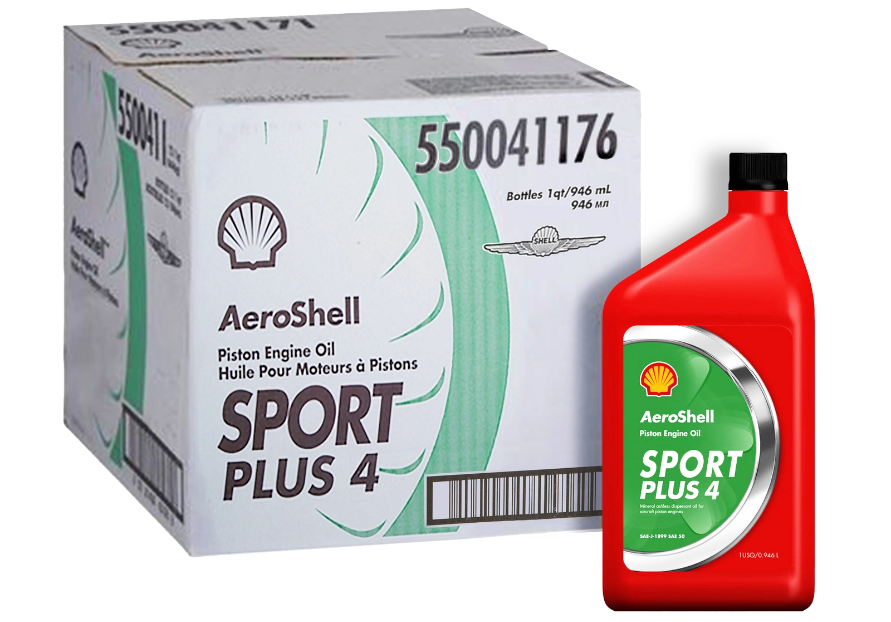
The pilot is responsible for ensuring that the airplane is properly loaded. Refer to AFM Section 6, page 104+ for appropriate loading instructions
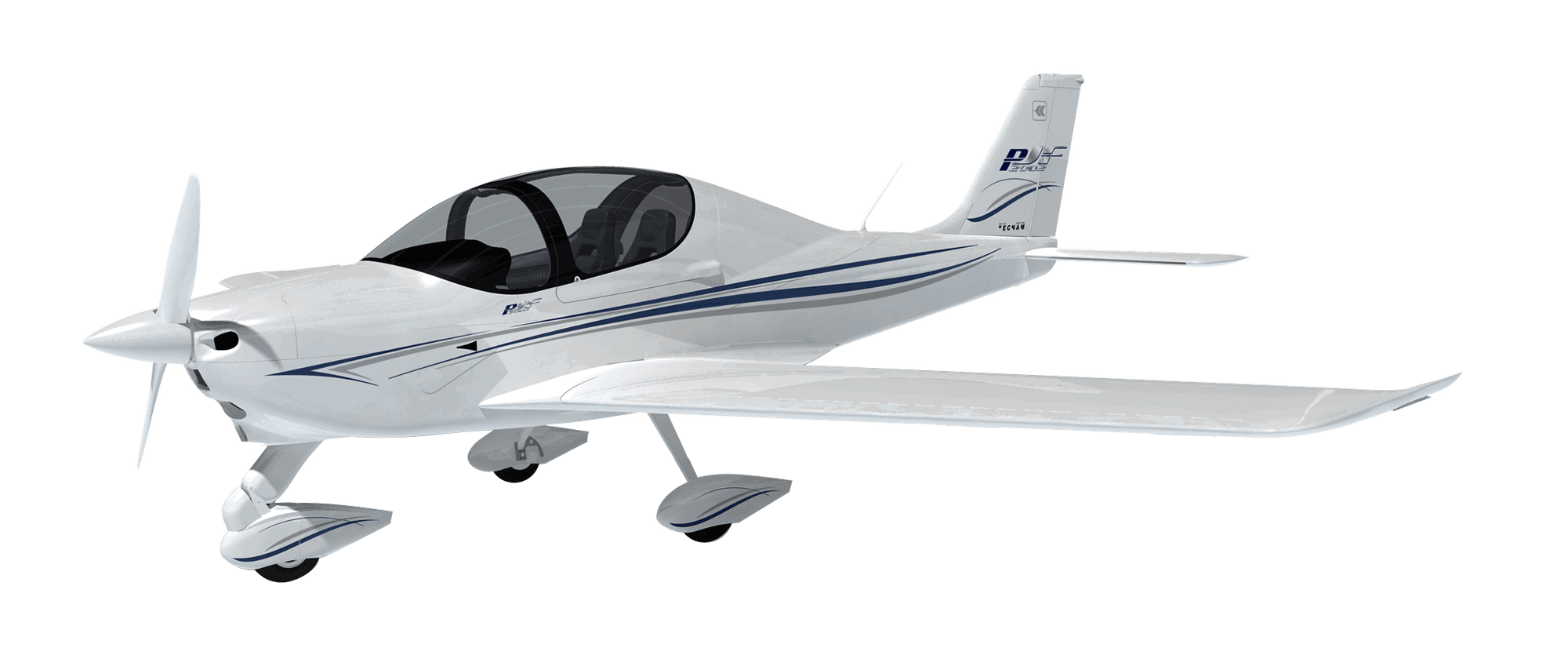
Tecnam P2002 JF
The TECNAM P2002-JF is a 2-seat, single engine, low wing aircraft developed for basic pilot training needs by Italian manufacturer TECNAM Costruzioni Aeronautiche S.p.A., based Capua just North of Napoli.
Powered by the popular ROTAX 912 engine and with avionics that incudes the GARMIN GMA430, the P2002-JF is one of the world’s most popular single engine trainer aeroplanes used by so many civilian and military flight schools.
The P2002-JF is certified according to the rules of the European Aviation Safety Agency (EASA) under certification specification CS-VLA i.e. Very Light Aircraft, is approved for flight training for the EASA and UK CAA Private Pilot Licence (PPL) and the aircraft is equipped with Night Visual Flight Rules (NVFR) instrumentation systems.
P2002-JF cockpit, avionics, design & features
The sliding canopy allows 360° of vision in the cockpit and offers high forward visibility over the cowling.
The flight deck integrates dual control sticks with an electric stabiliser.
P2002-JF features a fuselage installed with a fixed tricycle landing gear including a steerable nose wheel and dual conventional rudder pedals.
With a maximum take-off weight (MTOW) of 620 kg, it can carry a useful load of 240 kg, while the luggage area behind the seats can hold 20 kg of baggage.
The cockpit/cabin can accommodate a pilot and a co-pilot in a side-by-side seating arrangement. The adjustable seats are equipped with seat belts and shoulder harness systems.
The cabin features wall-to-wall carpeting, Map E storage pockets, fire extinguisher, soundproofing, first aid kit, fresh air vents, a heating system and an emergency hammer.
The TECNAM is equipped with a wide, conventional-type analogue instrument panel integrating a standard Garmin avionics package. The avionics suite includes a GMA 340 audio panel, communications system, Mode S transponder, magnetic compass, airspeed indicator, altimeter, heading and attitude indicators, flaps indicator and engine instruments.
Headset
ASA AirClassics HS-1A flight headset can be purchased at the Fly EPT Spain office, Son Bonet Airport, Palma de Mallorca

Aviation Headset Jack Adapter for TECNAM P2002-JF
The TECNAM accepts any twin plug headset, which are the most commonly used general aviation pilot headset, and have two (2) plugs at the end of the cable. The slightly larger one is for the headphone's audio while the smaller one is for the headset's microphone.

Best aviation Headset for general aviation pilots
Two of the best and most popular aviation headsets for general aviation aircraft include the Bose A20 (which can also be used on Airbus A320 and Boeing B737), and the David Clark h10-13.4 Aviation Headset
ROTAX 912 S2 engine
The TECNAM P2002-JF is powered by a ROTAX 912 S2 four(4)-stroke engine driving a 2-bladed fixed-pitch propeller.
The engine has a rated power output of 98hp (73kW) and burns AVGAS and cheaper MOGAS (automotive fuel with up to 10% ethanol content i.e. ordinary unleaded petrol which you put in the car)
TECNAM P2002-JF Instrument Panel
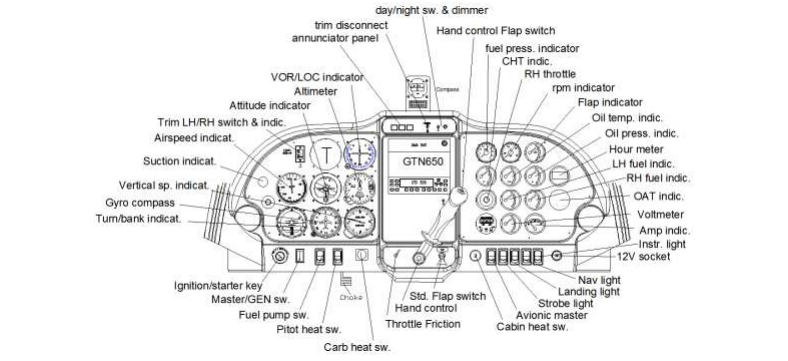
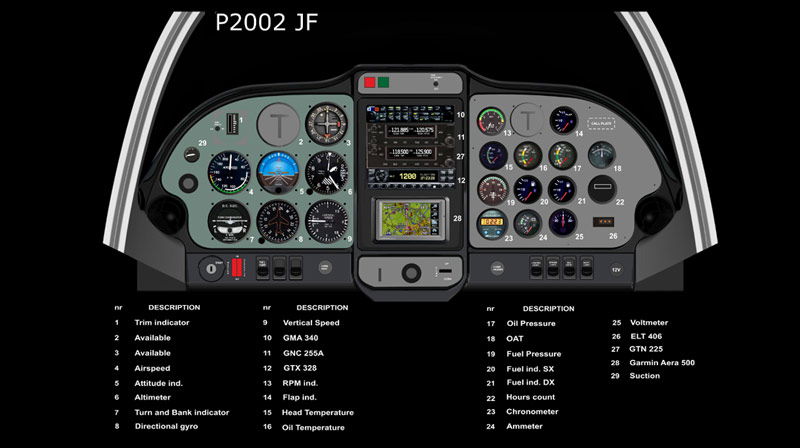
On Board Survival Equipment
With the aircraft being based on the Spanish island of Mallorca, there will be a short element of some cross country flight over water to reach the neighbouring islands of Menorca, and when flying to the Spanish mainland via Ibiza. With safety always on our mind first and foremost, we would like to address a few important safety points.
Firstly, Fly EPT Spain's TECNAM P2002-JF aircraft continuous airworthiness and rigorous maintenance program is under EASA Part-CAO. Maintenance is never deferred. All ADD's are complied with. Routine maintenance is scheduled every 50 hours, with 100 hour / annual checks performed, practically speaking, every single month. The engine / gearbox / propellor are replaced with new every 2,000 hours. Rest assured the entire aircraft fleet have been impeccably maintained since purchased new.
While the risk of an engine failure is relatively low, risk can be further minimized by the pilot in command (PIC) ensuring the following safety checks:
- Before commencing flight over water, fill up the Fuel tanks FULL up to maximum
- Before flight, always check the fuel for water contamination. After adding AvGas/MoGas, let the fuel tanks settle for 15 minutes before sumping them.
The following survival equipment is generally left either on board the aircraft or in the Fly EPT Spain office. For flights over water, take them with you and check to ensure they are onboard the aircraft, and annotate the flight plan accordingly:-
- EMERGENCY RADIO
- Emergency Locator Transmitter (ELT)
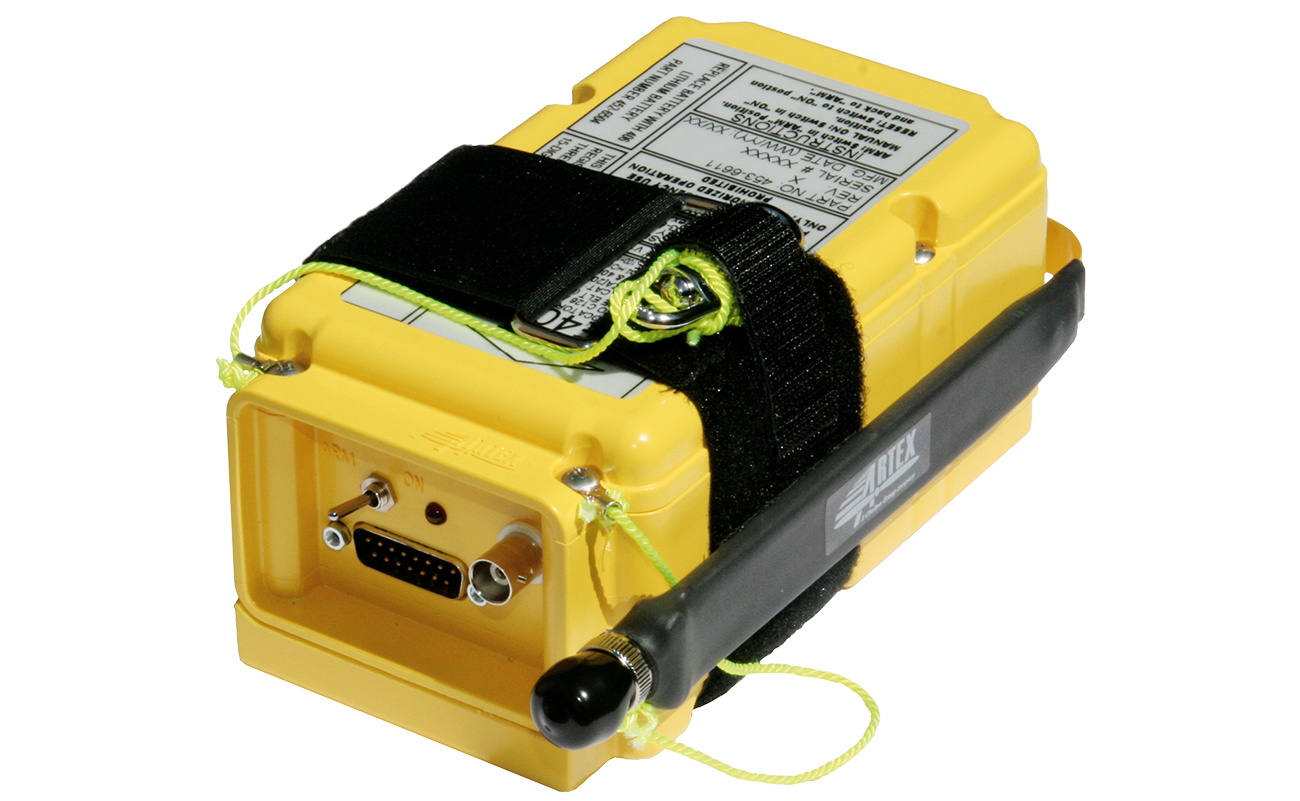
- SURVIVAL EQUIPMENT
- VHF (portable hand-held 2-way ground-to-air VHF Radio)
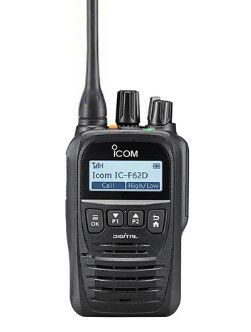
- MARITIME
- Life JACKETS (Note: Wear the life jacket when in-flight)
- Capacity: One (1) x inflatable Dinghy, Capacity: 2 persons, No cover, YELLOW




The dinghy life raft is a LALIZAS COASTAL COMPACT, without canopy, paddles, pump, Capacity: 2 persons
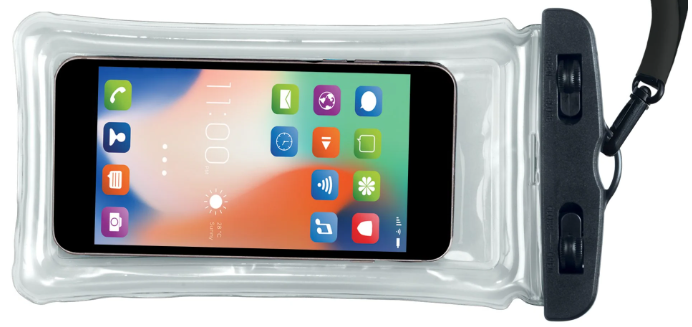
Keep you mobile phone and fully charged battery charger in a waterproof pouch. Save the following contact numbers:
Maritime Search and Rescue (SAR) ✈︎ Mallorca
- +34 971 724 562 and +34 900 202202
- Email: palma@sasemar.es
- MRCC Palma Majorca website
- Coastguard specific number: 900 202 202
Fly EPT Spain ✈︎ Flight Dispatch Policy (TECNAM P2002-JF)
1. Legal & Regulatory Compliance
All flight operations must comply with EASA / Spanish national civil aviation (AESA) regulations
Passenger-carrying requirement:
- At least 3 take-offs and 3 landings in the preceding 90 days
2. Insurance Requirements
- To be covered by the school insurance, pilots flying solo shall have:
- Minimum 2 hours flown on *MAKE & MODEL* (i.e. TECNAM P2002) in the last 90 days, including at least 1 hour with an instructor.
- Minimum 50 hours Total Time
- Flights that do NOT meet these requirements are NOT insured and will NOT be dispatched.
3. School-Specific Rules to Maintain Currency
- For pilots with:
<150 hours total time (TT): Minimum 1 flight every 45 days;
>150 hours total time (TT): One (1) flight every 60 days
- Currency exceptions:
- If a pilot has not flown in the last 45/60 days, as applicable, a check flight with an instructor is required before released for solo flight.
Note: These rules are stricter than legal requirements to maintain safety and insurance compliance.
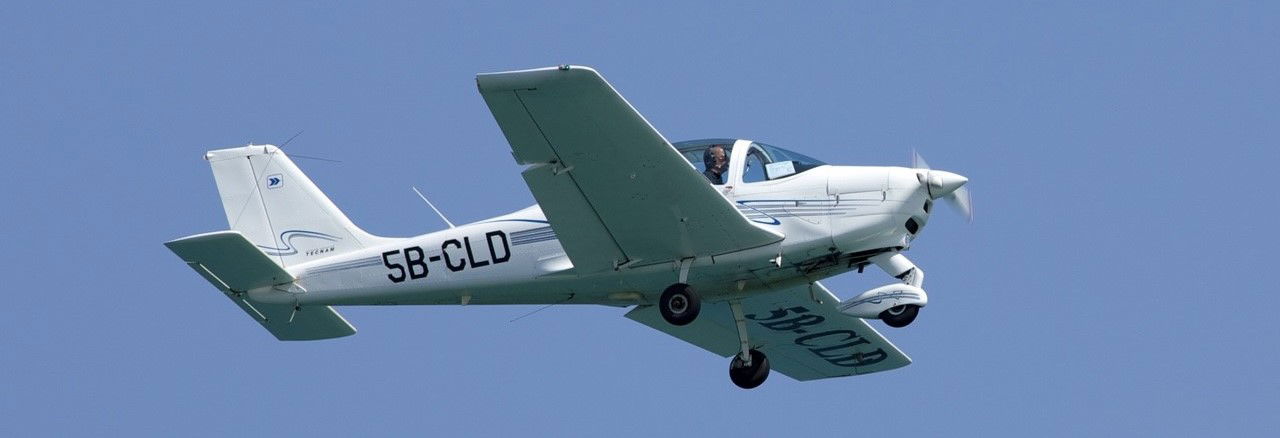
TECNAM P2002-JF flight training videos
My first Solo flight on the TECNAM P2002-JF
